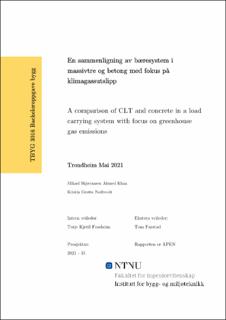| dc.contributor.advisor | Fossheim, Terje Kjetil | |
| dc.contributor.advisor | Farstad, Tom | |
| dc.contributor.author | Nødtvedt, Kristin Grøtte | |
| dc.contributor.author | Khan, Mikael Skjæraasen Ahmed | |
| dc.date.accessioned | 2021-09-20T16:27:50Z | |
| dc.date.available | 2021-09-20T16:27:50Z | |
| dc.date.issued | 2021 | |
| dc.identifier | no.ntnu:inspera:81154281:81155231 | |
| dc.identifier.uri | https://hdl.handle.net/11250/2779532 | |
| dc.description.abstract | Byggebransjen har et stort ansvar i kampen mot global oppvarming, og det har de siste årene blitt satt søkelys på å bygge mer bærekraftig enn tidligere. Bransjen har startet arbeidet, og de fleste nybygg i Norge kan flagge med miljøsertifiseringer eller miljøprofiler, som forteller hvor bærekraftig byggene deres er.
Denne oppgaven handler om hvordan klimagassutslipp og kostnader blir påvirket av et bærekraftig materialvalg, for et gitt prosjekt.
Oppgaven tar for seg et referansebygg på Hasle i Oslo. Bygget faller under kategori næringsbygg, og bæresystemet skal bygges opp i en kombinasjon av massivtre og limtre. Dette bygget blir sammenlignet med en tilsvarende versjon av bygget, med bæresystem i betong. Målet er å finne kostnadsdifferansene og avgjørende faktorer for hvor mye en kan redusere klimagassutslippet som følger av materialvalg.
Det har blitt utarbeidet klimagassregnskap for begge bæresystemene ved hjelp av programmet One Click LCA. Dette programmet har også blitt benyttet til å lage et referansebygg, som representerer et estimat på de totale klimagassutslippene til et tilsvarende, komplett bygg i betong. De to klimagassregnskapene for bæresystemene har blitt sammenlignet opp mot hverandre, og opp mot det komplette referansebygget i betong. For massivtrebygget har det blitt sett på syv ulike produsenter av massivtre, som potensielle leverandører til bygget.
Det har også blitt laget estimater på merkostnadene som følger av bygging med massivtre kontra betong. To ulike estimater er lagt til grunn, hvor et er utarbeidet av oppdragsgiver og gjelder de totale entreprisekostnadene, og et er fremstilt av bachelorgruppen og omhandler materialkostnadene. Masseberegninger og Norsk Prisbok 2017 har vært utgangspunktet for sistnevnte.
Resultatene viser at en kan redusere klimagassutslippene med mellom 16,6 % og 31,0 % i forhold til totalen til referansebygget i betong, avhengig av hvilken produsent en benytter seg av. Oppdragsgiver estimerer at økningen i entreprisekostnader for massivtrebygget ligger på 18,2 %, og bachelorgruppen sitt estimat tilsier at det er en økning på 13,4 % i materialkostnadene til bæresystemet over grunnplan. | |
| dc.description.abstract | The building industry has a great responsibility in the fight against global warming, and in the last, few years there has been an increased focus on building more sustainably than before. The industry has started, and most new buildings in Norway can flag with environmental certifications or environmental profiles, which tells us how sustainable their buildings are.
This thesis is about how greenhouse gas emissions and costs are affected by a sustainable choice of materials, for a given project.
The thesis addresses a reference building at Hasle in Oslo. This building falls under the category of commercial buildings, and the load-bearing system will be built in a combination of CLT and glulam. This building is compared to a similar version of the building with a concrete support system. The goal is to find the cost differences and decisive factors that can tell how much one can reduce the greenhouse gas emissions as a result of choice of materials.
Greenhouse gas accounts have been calculated for both support systems using the One Click LCA program. This program has also been used to create a reference building, which represents an estimate of the total greenhouse gas emissions for a similar, complete building in concrete. The two greenhouse gas accounts for the load-bearing systems have been compared against each other, and against the complete reference building in concrete. For the CLT-building, seven different manufacturers of CLT have been examined as potential suppliers to the building.
Estimates have also been made for the additional costs that comes with construction in CLT versus concrete. Two different estimates have been used, one of which has been calculated by our external supervisor and applies to the total enterprise costs, and one has been made by the bachelor group for the costs of the materials. Mass calculations and the Norwegian Price Book 2017 have been the foundation for the latter.
The results show that greenhouse gas emissions can be reduced by between 16.6 % and 31.0% in relation to the total for the reference building in concrete, depending on which suppliers one uses. Our external supervisor estimates that the increase in the enterprise cost of the CLT building is 18.2 %, and the bachelor group's estimate indicates that there is an increase of 13.4 % in the material costs of the load-bearing system above ground level. | |
| dc.language | nob | |
| dc.publisher | NTNU | |
| dc.title | En sammenligning av bæresystem i
massivtre og betong med fokus på
klimagassutslipp | |
| dc.type | Bachelor thesis | |
